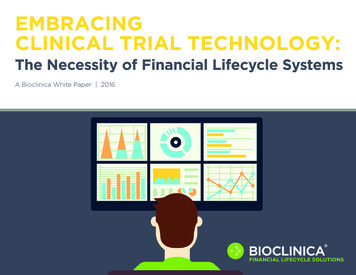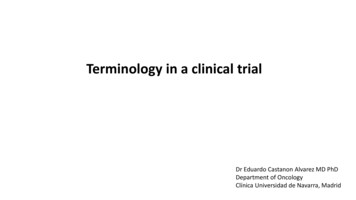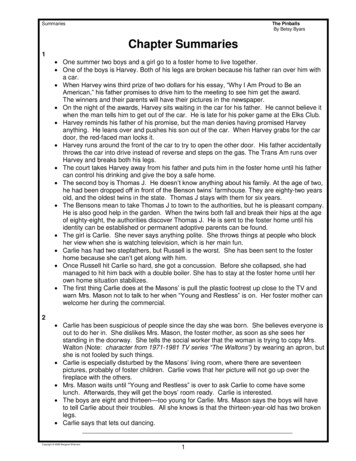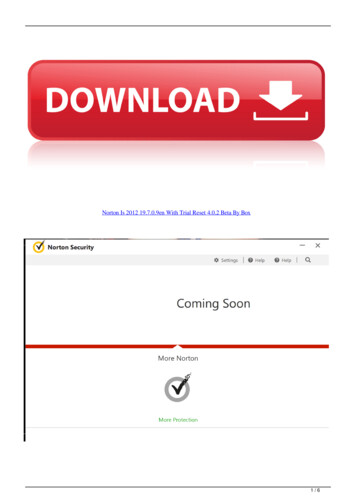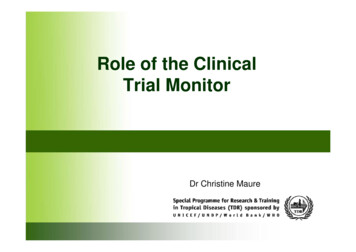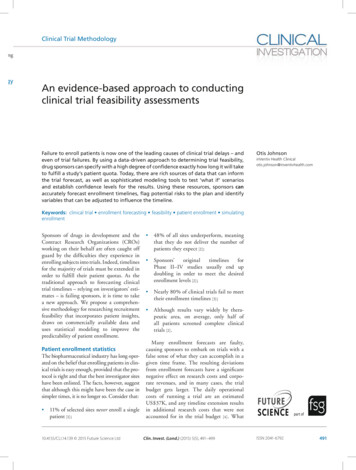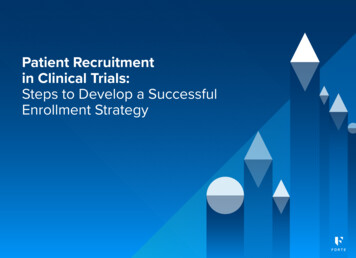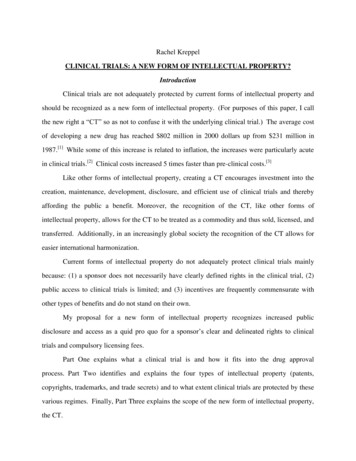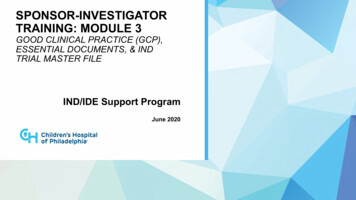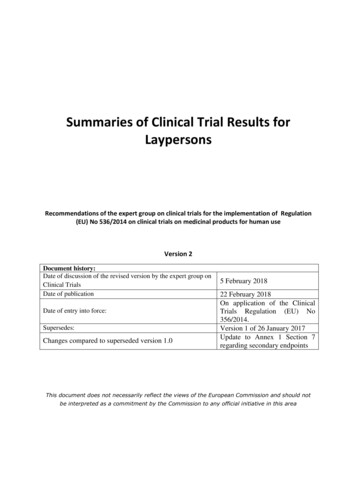
Transcription
Summaries of Clinical Trial Results forLaypersonsRecommendations of the expert group on clinical trials for the implementation of Regulation(EU) No 536/2014 on clinical trials on medicinal products for human useVersion 2Document history:Date of discussion of the revised version by the expert group onClinical TrialsDate of publicationDate of entry into force:Supersedes:Changes compared to superseded version 1.05 February 201822 February 2018On application of the ClinicalTrials Regulation (EU) No356/2014.Version 1 of 26 January 2017Update to Annex 1 Section 7regarding secondary endpointsThis document does not necessarily reflect the views of the European Commission and should notbe interpreted as a commitment by the Commission to any official initiative in this area
Summaries of Clinical Trial Results for Laypersons26 January 2017Contents1.Introduction . 32.Scope . 33.Responsibility of sponsor . 34.General Principles . 35.Health Literacy Principles and Writing Style . 46.Readability and use of plain language . 67.Numeracy . 68.Visuals . 79.Language . 710. Communication of return of results to participants . 8References . 9Annex 1 – Templates with example wording. 11Annex 2 – Neutral language guidance in describing results . 27Annex 3 - Examples of readability tests by country . 292
Summaries of Clinical Trial Results for Laypersons26 January 20171. IntroductionThe EU Clinical Trials Regulation 536/2014 (Article 37) (EU CT Regulation) requires sponsors toprovide summary results of clinical trials in a format understandable to laypersons. These laypersonsummaries will be made available in a new EU database once it becomes available and is approvedaccording to the timelines set forth in the Regulation. Prior to this Regulation and the creation of anew EU database, the EudraCT Results data model, launched in July 2014, had been used for postingof scientific results written in technical language under the Commission Guidelines 2012/C 302/03,which was not easily accessible or understandable to the layperson.Annex V of the EU CT Regulation sets out ten elements that must be addressed in the lay summaries.This document includes guidance and templates to help authors writing these lay summaries.Consistency in the way trial results are presented will help improve familiarity and comprehensionby the general public, participants, patients, and others.2. ScopeThis document provides sponsors and investigators with guidelines and templates for theproduction of summaries of clinical trial results for laypersons. These guidelines will only apply to laysummaries included in the EU database. The lay summary section of the EU database will be publiclyavailable. The general public are expected to be the primary audience for the lay summaries. The laysummaries may also be accessed by others, such as research participants, healthcare professionals,and academics. Given this wide audience, the summaries will need to take into account the averageliteracy level of the general population, provide simple explanations, and apply other measures tosupport health literacy1.3. Responsibility of sponsorIt is the responsibility of the trial sponsor to ensure that the lay summary is developed andsubmitted to the EU database within the timelines required by applicable regulation.4. General Principles 1Develop the summary for a general public audience and do not assume any prior knowledge ofthe trial, of medical terminology or clinical research in general.Develop the layout and content for each section in terms of style, language, and literacy level, tomeet the needs of the general public.Keep the document as short as possible, avoid simply copying text from the technical summary.Explaining technical terms in a simple language may increase the number of words andtranslation to some languages will result in longer documents than others. All content must be“Health literacy is the degree to which individuals have the capacity to obtain, process, and understand basichealth information and services needed to make appropriate health acy/quickguide/factsbasic.htm3
Summaries of Clinical Trial Results for Laypersons26 January 2017 carefully considered for inclusion since additional content worded in plain language may addconsiderable length which in and of itself may decrease comprehension.Focus on unambiguous, factual information.Ensure that no promotional content is included (See neutral language guidance in Annex 2).Follow health literacy and numeracy principles (see section 5 ‘Health Literacy Principles andWriting Style’ and section 7 ‘Numeracy’).Consider involving patients, patient representatives, advocates or members of the public in thedevelopment and/or review of the summary to assess comprehension and the value of theinformation provided. This won’t be feasible for some studies, but where it is a possibility, it mayenhance the final version. Medical writers with particular experience of writing in plainlanguage for the public who are also able to incorporate health literacy and numeracy principlesmay be helpful in developing summaries for the lay person.5. Health Literacy Principles and Writing StyleCommunications written for the public should use simple everyday language to ensure ease ofreading and understanding. Text should be suitable for people with a low to average level of literacy. Across Europe, theaverage proficiency level is 2 -32. A proficiency level of 2 is defined as being able to identifywords and numbers in a context and being able to respond with simple information, such asbeing able to fill in a form. A proficiency level of 3 is defined as being able to identify,understand, synthesize and respond to information, be able to match given information thatcorresponds to a question. This level corresponds roughly with high (secondary) schoolcompletion levels.Avoid long and complex sentences that include many clauses as these are difficult to understand.Use simple vocabulary familiar to non-medical people: Use active, rather than passive, voice: 2Avoid jargon, technical, medical or scientific language (for example, use “high bloodpressure” rather than “hypertension”)Remove unnecessary or complex words (for example, “use” rather than “utilise”)Be consistent in the use of terms/words throughout the document, and define themEnsure that the underlying concepts are clear and easy to understand. Where necessary,explain the underlying conceptAvoid ambiguous words and phrases (for example, “felt badly”)Active voice: “Researchers studied the effect of tamoxifen on breast cancer”Passive voice: “The effect of tamoxifen on breast cancer was studied by researchers”Based on research across Europe, text for the lay summary should be aimed at a literacy proficiency level of2 - 3. The International Adult Literacy Survey (IALS) identifies five levels of proficiency ranging from level 1(lowest level of proficiency in literacy, that is basic identification of words and numbers ) to level 5 (highestlevel of proficiency in literacy, that is able to understand and verify the sufficiency of the information,synthesize, interpret, analyse and discuss the information. At level 5, the individual demonstrates sophisticatedskills in handling information).4
Summaries of Clinical Trial Results for Laypersons26 January 2017 Use the following elements to help improve comprehension: Headlines and descriptive subheadings to organise informationPresentation of the “big picture” before the detail (inverted pyramid writing style)Bullet points instead of paragraphsNumeracy principles to describe data and statistics (see section 7 below)Adequate “white space”. For example, separate topics by one or two lines12-point font should be used (where needed, readers may enlarge print when viewingelectronically or print pdf in larger font)The most readable colour combination is black text on a white background. Please avoidusing white text on a coloured background as this can be harder to read. Keep in mindhow documents will look when online or printed.Links to additional information, and resources for online summaries and backgroundinformation. Such links need to be minimal since hyperlinks can become out of dateover time.Limited use of unnecessary imagery that does not enhance understanding (icons, logos,etc.)Avoidance of text in ALL CAPS and underliningUse visuals (for example, simple graphs) to convey messages where helpful. Avoidoverwhelming the reader with too much information.Where possible, avoid using acronyms, abstract, medical/technical, or multisyllabic words (such as,“unanticipated”, “hematopoietic”). If such words are to be used (for example, where commonly usedmedical terms will also aid in finding other medically relevant information and referencing otherdocuments), add clear language to define the word followed by the term in parenthesis. Forexample, cancer that has spread to another part of the body (metastases). Also, where medicalterminology refers to defined stages of a condition, it may be helpful to express the stages as mild(stage 1), moderate (stage II), severe (stage III) and very severe (stage IV) as appropriate.Finally, it is helpful to use language in a way that is respectful and empowering for patients. Forexample, words such as “demented” in dementia research should be avoided. Similarly, avoid usingthe words “sufferers” or ”victims” that have negative connotations. A preferable term is ”peopleliving with ” or ”people affected by ”.Sponsors should note that there is no limit placed on the size of the lay summary document that willbe uploaded as a pdf document. However, it should be as succinct as possible while relaying therequired information in a form that is readily understandable. Whilst brevity is preferable,explaining technical terms and complex concepts in a simple language will often use more wordsthan a technical term.5
Summaries of Clinical Trial Results for Laypersons26 January 20176. Readability and use of plain languageSentences should be kept short and succinct. The summary should remain factual and objective,avoiding any promotional language (See neutral language guidance in Annex 2) or promotionalperception through formatting or tone3.Sponsors are encouraged to use a language-specific reading test to assess the literacy level of eachlay summary produced. Sponsors should understand, however, that even though lay summary textmay indicate an optimal reading level, the summary may not be clear or readily understandable.Many simple sentences together may explain little or nothing despite the fact that each sentence issimple, straightforward and grammatically correct. Nonetheless, these readability tests may beuseful tools in striving to make often complex information understandable. While approaches wereinitially only developed for the English language, tools are now available in other languages (SeeAnnex 3 for further information). These tools use a variety of metrics to provide a correspondinggrade level (for example, average numbers of words per sentence and syllables per word).A well written lay summary would normally be accessible by young people from the age of 12 yearsupwards. Sponsors of paediatric studies may consider developing a child-focused version of the laysummary, particularly where they have already developed child-focused Patient Information Sheets.Paediatric focused lay summaries may differ in terms of presentation and style (more illustrations orgraphics) to assist children in understanding trial results, over and above what is required under theEU CT Regulation. Enabling increased understanding of results by the general public will also helpparents and caregivers explain results to others, including children who have participated in a trial.Where feasible, sponsors should consider testing the readability of the summary with a smallnumber of people who represent the target population. Depending on the nature of the study, thiscould be patients with a particular disease or members of the public. Their feedback andsuggestions could be helpful in developing a summary that lay people will understand.7. NumeracyTrial results summaries are likely to include a variety of numerical data that should be easilyunderstandable by the target audience. Some key principles to consider when using numbers in alay summary are: 3Present absolute numbers but also consider conveying numerical information in other ways suchas a percentage, rather than relative risks, odds ratios etc.Use whole numbers rather than decimals to the extent this is possible without increasingconfusion should the lay summary be cross referenced with the scientific summary.See ‘Recommendations for Drafting Non-Promotional Lay Summaries of Clinical Trial otionalLanguage-Guidelines-v10-1.pdf. TransCelerate BioPharma (2015)6
Summaries of Clinical Trial Results for Laypersons26 January 2017Further detail on how to apply principles of numeracy can be found in Appendix 4 of the MRCTReturn of Results Guidance Document, Version 2.1, July 13 2016 – Multi-Regional Clinical TrialsCenter of Brigham and Women’s Hospital and Harvard.8. VisualsWell-chosen and clearly designed visual aids can help enhance understanding of text and their use isencouraged. Summaries of clinical trial results that combine clear infographics with explanatorytext can be a good way of presenting information. Basic principles to follow include: Where used, visuals should present a simple message and be clearly labelled with captions;consider how a visual aid helps to reduce the need for lengthy text. Visuals should always beaccompanied by a simple textual explanation and placed near the text that they illustrate.Avoid using overly complex images, such as graphs showing several relationships, since they canbe easily misinterpreted.Graphs using potentially misleading axes labels should be avoided. Consider the scales you areusing in any graph and whether the axes need to start at zero to avoid confusion. Ensure that allyour graphical images are clearly labelled.Creative solutions to ensure understanding could include cartoons and illustrations.Finally, although colour adds interest, any visuals or graphics should still be clear if printed inblack and white.For examples of clearly laid out visuals which aid understanding see the Understanding Immunooncology for kidney cancer website which uses infographics to display clinical trial results.9. LanguageAs a minimum, the summary is expected to be provided in the local language of each of the EUcountries where the trial took place. The specific local languages selected should match thelanguages employed in the Patient Information Sheet for that trial in each country (pdf versions oftranslated lay summaries will need to be uploaded separately). Where resources allow, sponsorsshould consider including an English version if the trial did not include the Republic of Ireland orMalta, as the use of a common language will allow greater accessibility across the EU and globally,however this is not mandatory.Where translation is required for multi-country trials, care should be taken to ensure that theoriginal meaning and non-promotional nature of the summary are maintained. Translatedsummaries should also take into account the cultural validity of the medical or technicalterminology used.7
Summaries of Clinical Trial Results for Laypersons26 January 201710. Communication of return of results to participantsThe summary for lay persons in the EU database should not be regarded as the only way ofcommunicating with trial participants. Although not required by regulation, sponsors may providetrial results to investigators or third parties to feedback to patients who have taken part in theirtrials, along with an acknowledgement of their contribution and an expression of appreciation,rather than solely directing them to the lay summaries on the EU portal .8
ReferencesHealth literacy:Apter, A. J., Paasche-Orlow, M. K., Remillard, J. T., Bennett, I. M., Ben-Joseph, E. P., Batista, R. M.,Hyde, J. & Rudd, R. E. (2008). Numeracy and communication with participants: they are counting onus. Journal of General Internal Medicine, 23(12), 2117-2124.Center for Information and Study on Clinical Research Participation (CISCRP) (www.ciscrp.org)Centers for Disease Control and Prevention. (2010). Simply put: A Guide for creating easy-tounderstand materials. http://www.cdc.gov/healthliteracy/pdf/simply put.pdfDeWalt, D.A., Callahan, L.F., Hawk, V.H., Broucksou, K.A., Hink, A., Rudd, R., Brach, C. (2014).Health Literacy Universal Precautions Toolkit. ex.html Pages 49-59Doak, C., Doak, L., & Root, J. (1996). Teaching patients with low literacy skills (2nd ed.). Philadelphia:J.B. Lippincott Company. h Literacy Missouri Best Practices for Numeracy (www.healthliteracymissouri.org)Houts, P.S., Doak, C., Doak, L.G., Loscalzo, M.J. The role of pictures in improving healthcommunication: a review of research on attention, comprehension, recall and adherence. Pat EduCoun. 2006; 61(2):173–190.Jacobson, Kara L., and Ruth M. Parker. (2014) "Health Literacy Principles: Guidance for MakingInformation Understandable, Useful, and Navigable." Institute of Medicine of the NationalAcademies, 22 Dec. 2014. ndable-useful-and-navigable/A synthesis of health literacy principles used to create health information that is better aligned withthe skills and abilities of those using that information.Jacobson, Kara L., and Ruth M. Parker. (2014) "Health Literacy Principles Checklist." Center forHealth Guidance, 2014. -principles-checklist.pdfA user-friendly checklist to apply health literacy principles.Kirsch,I. The International Adult Literacy Survey (IALS): Understanding What Was Measured.Educational Testing Service. December 2001. sch.pdfMRCT Return of Results Guidance Document, Version 2.1, July 13 2016 – Multi-Regional ClinicalTrials Center of Brigham and Women’s Hospital and Harvard.MRCT Return of Results Toolkit, Version 2.2, July 2016 – Multi-Regional Clinical Trials Center ofBrigham and Women’s Hospital and Harvard.Nielsen-Bohlman, L., Panzer, A., & Kindig, D., Eds. (2004). Health literacy: a prescription to endconfusion. Washington, DC: The National Academies Press. .pdfSroka-Saidi K, Boggetti B, Schindler T.M. Transferring regulation into practice: The challenges of thenew layperson summary of clinical trial results. Medical Writing 2015, Vol 24, 1, 9/2047480614Z.000000000274Stableford, S. & Mettger, W. (2007). Plain language: a strategic response to the health literacychallenge. Journal of Public Health Policy, 28(1), 71-93.For more information: OECD (2013), OECD Skills Outlook 2013: First Results from the Survey of Adult Skills, OECDPublishing http://www.plainenglish.co.uk/free-guides.html www.plainlanguage.gov sh-summaries/
10Health literacy: a prescription to end confusion: -Language-Guidelines-v10-1.pdfThe Centers for Disease Control and Prevention (CDC) has developed extensive health literacyresources including links to free training and an assessment tool:o Overview: http://www.cdc.gov/healthliteracy/o Free online training: o Assessment tool: http://www.cdc.gov/ccindex/index.html
If the full title is lengthy and/or complicated then also provide a shorter and/or simpler lay titleupfront followed by the full title. A short title alone may lead to confusion with other similarstudies. Avoid technical terms and explain them further down in the document if necessary. Thetitle should focus on the basic aim of the study.1.2 Protocol number1.3 EU Trial number1.4 Other identifiers Other identifiers refer to EudraCT number, WHO ICTRP number, US NCT number, ISRCTN numberif available, etc.1.5 AbstractInclusion of an abstract is not mandatory but will help the reader identify whether they wish to readthe whole summary. Give a very short description of the trial including: Purpose of the studyWhat was tested: the intervention and any comparators, the Phase of the trial where applicablePeople taking part in this trial: including total number of particpants across x countriesTopline results: Simple description of the result of the primary endpointSafety: overall statement about the the safety findings in the study.For example:12
3.2 When was this study done? The overall trial start and end dates. For example:This trial started in December 2014 and ended in March 2017. Where a clinical trial has had to close early, the information included in the summary shouldexplain the reason for this, for example, evidence of lack of efficacy, safety events, poorrecruitment etc.Sponsors may want to specify follow up periods here for some longer trials.3.3 What was the main objective of this study?This section should specify: The purpose of the trial (for example, finding a safe dose, comparing treatments, etc.) / why thetrial was carried out.Why the comparator was chosen, for example, the comparator is regarded as standard treatmentfor this condition.Any critical changes made during the study. For example, if the dosage used was changed or ifthe trial stopped early due to efficacy or side effects this should be noted.Avoid the use of unfamiliar abbreviations, acronyms and medical terms, for example “RCT” forRandomised Controlled Trial. Explain the concept simply. If you wish to use a medical term, useit in brackets after the simple explanation.Suggested wording for different phases of clinical trials:Phase 1:In this study, researchers looked at how this drug works in the human body. Researchers didmedical tests on men and women before and after they took the drug. The researchers wanted toknow if there were: Any chemical changes in blood or urine, and Any unwanted side effects of the drugThis trial did not test if the drug helps to improve health. [Patients/healthy volunteers]took part in this study.Phase 2 trial:14
In a Phase 2 study a new treatment is tested in a small number of patients [amend as appropriate]. Inthis study, researchers gave medicine X to patients with diabetes to find out if medicine X loweredthe amount of sugar in their blood.Phase 3 trial:In a Phase 3 study a new treatment is tested in a large number of patients [amend as appropriate].In this study, researchers compared the test medicine to the standard treatment used for[disease/condition] or placebo (identical looking tablets but with no medicine in them).Phase 4 trial:This trial was carried out after the new treatment had been approved for use (meaning that thetreatment can already be prescribed by doctors). Researchers looked at the effect of the newtreatments in a larger number of people.Randomisation:“People with diabetes were put into 2 groups by chance (randomised) to reduce differences betweenthe groups. Putting people into groups by chance helps to make the 2 groups equal Reducingdifferences between the groups in this way, makes the comparison between the groups fairer.Blinding:[If the trial was double-blinded, also add the following wording] This trial was also “double-blinded”.This means that neither patients nor doctors knew who was given which treatment/drug. This wasdone to make sure that the trial results were not influenced in any way.[If the trial was single-blinded, use the following words]This trial was single-blind. This means thatthe patient did not know who was given which treatment they were given but the doctor did know.[If not randomised, list how many patients/people were in each group, and how this wasdetermined.]15
The primary endpoint(s) and results by trial arm which were pre-specified by the statisticalanalysis plan as a primary endpoint.Additional safety data important to the overall results of the trial.Sponsors should reference the complete list of outcomes based on all endpoints available inthe technical results summary for each clinical trial in the EU database including patientrelevant secondary endpoints.Describing numerical concepts to a lay audience can be difficult and sponsors should follow thefollowing guidance: Outcomes should be described using numeracy (x out of xx people [xx%]) and plain languageprinciples.Refrain from using technical terms such as ‘number needed to treat’, ‘odds ratio’, ‘confidenceinterval’ etc. If technical terms are included, then they need to be explained in simplelanguage.If reference is made to numerical differences that are not statistically significant, this shouldbe explained to the reader. For example:Group A had lower blood sugar levels than Group B but the difference between the groups islikely to be by chance rather than a difference caused by the treatment. Further guidance on providing numerical information can be found atwww.healthliteracymissouri.org/.The following table lists common clinical trial endpoints in simple language. Terms are defined withgeneral descriptions, followed by examples of simple, plain language that can be used in summariesof clinical trial results for laypersons. Please select those examples that relate to the type of outcomein your trial.EndpointOriginal description of the typeof endpointExample of desirable simple, plainlanguageCompositeA composite endpoint, as theprimary endpoint, combinesmultiple outcomes (for example,death, getting sick again (relapse),serious event) and test results intoone measure of how well the“The XXX trial measured [patients/people]to see if those in Group A (ABC treatment)or Group B (XYZ treatment) lived longer, hadfewer heart attacks, or fewer hospital visitsfor heart failure.These outcomes were measured together19
drug/therapy/device works. This isuseful when there are manydifferent outcomes that canhappen during a trial. This can alsobe called a combined or multi-partendpoint.(combined) because each one is quite rare.Researchers also wanted to see if the drugworked in patients who had all 3 conditions.The trial found that there was no change inthe number of outcomes for[patients/people] in Group A or Group B.”Dose EscalationDose escalation is sometimes usedin phase 1 studies to measuresafety. People in the trial startwith a low dose of the medicine(drug). If that dose does not causesafety problems, then morepeople are given a higher doseuntil there are too many safetyissues. The highest dose that istolerated is called the maximumtolerated dose (MTD).“This trial was undertaken to find thehighest [dose/amount] of treatment thatpeople could safely take [or use] withouthaving severe side effects.”Mortality /Overall SurvivalThe goal of this trial was to see ifTreatment ABC or Treatment XYZhelped patients with[disease/condition] to live longer.“This trial compared patients in Group A(Treatment ABC) to those in Group B(Treatment XYZ) to see who lived longer.If there was no effect –“Patients in both groups lived about thesame amount of time, no matter whattreatment they got.”If there was an effect (statisticallysignificant) –“The times given below refer to the averageamount of time that [patients/people] inthis study lived.Some [patients/people] lived for a shortertime and some lived longer.People in Group A (ABC treatment) livedabout 15 months.People in Group B (XYZ treatment) livedabout 12 months.20
This means that people in Group A (ABCtreatment) lived on average 3 monthslonger than people in Group B.”MorbidityMorbidity endpoints are thosethat measure the severity ofdisease, or when the patientexperiences a new disease orillness.“People with diabetes were put into 2groups by chance (randomised) to reducedifferences between the groups.Group A received drug X, Group B followed adiet and exercise program. A
(EU) No 536/2014 on clinical trials on medicinal products for human use Version 2. Document history: Date of discussion of the revised version by the expert group on Clinical Trials . 5 February 2018 . Date of publication . 22 February 2018 . Date of entry into force: On application of the Clinical Trials Regulation (EU) No 356/2014. Supersedes:
